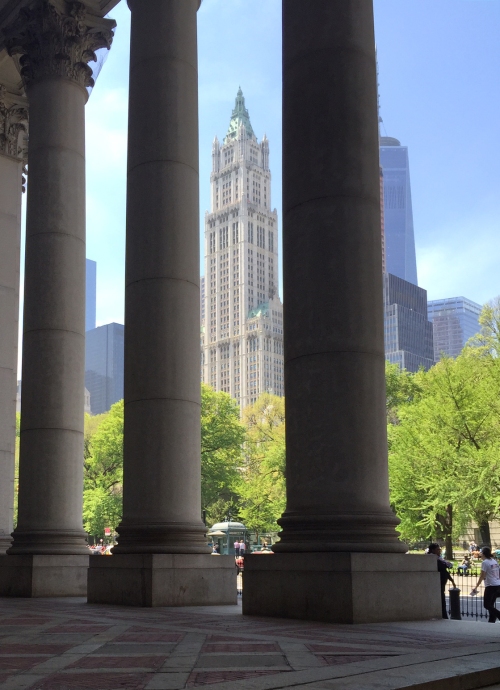
More about the building’s history here. Incredible details. Click on the above photo to see my full album!
Lower Manhattan
New York City: A Century of Zoning

The last straw. The 1913 Equitable Building led to passage of the 1916 law.
Today is the 100th anniversary of New York City’s original zoning ordinance. In commemoration of a century of land use regulation (it was also America’s first zoning law), the local chapter of the AIA has published Zoning at 100, which includes a number of essays by top architects, planning officials, and scholars, looking back, and looking forward. (Thanks to H. for the link!) Authors include Robert A.M. Stern, Bill Rudin, Carl Weisbrod, and Gina Pollara. Looking forward to finding some time to read these.
Here are a few more pictures I’ve taken of the massive 1913 Equitable Building, located at 120 Broadway, which put the issue of development massing at the forefront of city politics, and led to the law.
Spotlight: Trinity Church, Broadway & Wall Street
Spotlight: Liberty Tower, Liberty & Nassau Streets
Spotlight: Castle Clinton & Hudson River Twilight

Click on the above photo to see my full album!
Out for a walk one evening in June, while Honey was attending a class, I wound up at Castle Clinton, near the tip of Manhattan. It is a national landmark that I had heard of, but whose claim to fame I did not know, so I read one of the NPS guides that was posted on site. Apparently, Castle Clinton was an unused military facility after the War of Independence; then a public amphitheater in the mid-19th century; an intake center for European immigrants, before Ellis Island was established; and, finally, the original NYC Aquarium. Today, it’s back to being a presentation space. That night in June, I walked into an incredibly well acted performance of Romeo and Juliet, just in time to catch the last few dramatic scenes. Afterwards, I walked back along the Hudson River.
Spotlight: Two Bridges (From Below)
Spotlight: The Old Jewish Lower East Side
Spotlight: Pierpont Morgan

Click on the above photo to see my full album!
The main building on this campus was J. Pierpont Morgan’s private house, and included an incredible private library, complete with mezzanines and bookshelves that turn to reveal hidden, spiral staircases. The architectural detail of this property, alone, makes it worth a visit. The displayed collection currently includes a Gutenberg Bible, an original manuscript by Mozart, and a painting by Leonardo Da Vinci’s teacher. J.P. Morgan was also an avid collector of cylinder seals from the ancient world (little spools of lapis lazuli, obsidian, or other hard materials, that were carved with a unique image and pressed into hot wax in order to verify the authenticity of a document or packaged good). Morgan became something of an expert on these, and many items from his collection are displayed. Fascinating stuff.
Spotlight: New York’s City Hall
I took these pictures in October 2015, during a visit that I made to City Hall (1802-12), with Honey, as part of Open House New York. City Hall is located in New York’s historic town green — the topic of a previous LT post. My current office is at 250 Broadway, which is the glass building located just to the right of the Woolworth Building in a couple of the outdoor photos. More about the history and architecture of City Hall can be found here. Images of the Council Chamber, including its incredible ceiling, are at the end of the series.
Spotlight: New York’s Town Green
Today’s City Hall Park sits on the oldest part of the New Amsterdam and New York Commons — a public site in the planning tradition of the northern European town green. The Commons dates from the 1600s, and its checkered past has included workhouses for the poor, a burial ground for the colonial town’s African slaves, and many public executions — as well as the civic and religious buildings and military parade grounds that have historically been located at town centers.
Here are some photos I recently took in City Hall Park:
I think it’s interesting that, after almost four centuries, this park continues to function as a living gathering place in the city’s center. I recently ate lunch in the park. I listened to a man play the saxophone, beside the fountain; I noticed others spending their lunch hours there, reading the paper, tapping at a cell phone, or having a smoke. Tourists passed through and took pictures; poor people asked strangers for money; a man napped on the grass in the shade.
What draws everyone in, day after day? Is it the patch of nature? Views of the surrounding architecture? The buzz of human activity? The respite from car exhaust and street noise? How many of them realize that they’re not just passing through one of the city’s hundreds of small parks, but taking part in a 400-year-old tradition? That they are standing in what was once the only town green of a strange and distant colonial outpost of Western Europe?
Meanwhile, the city’s largest cluster of courthouses and public office buildings sits around Foley Square, a few blocks north along Centre Street. (Note that the English spelling is still used.) This is roughly where the northern end of the Commons once was, and its intensity of public uses represents the centuries-long persistence of the tradition of siting your community’s civic buildings near the town green:
Here’s a map of the Commons from about 1754:
And an overlay with today’s landmarks:
And some thoughts:








